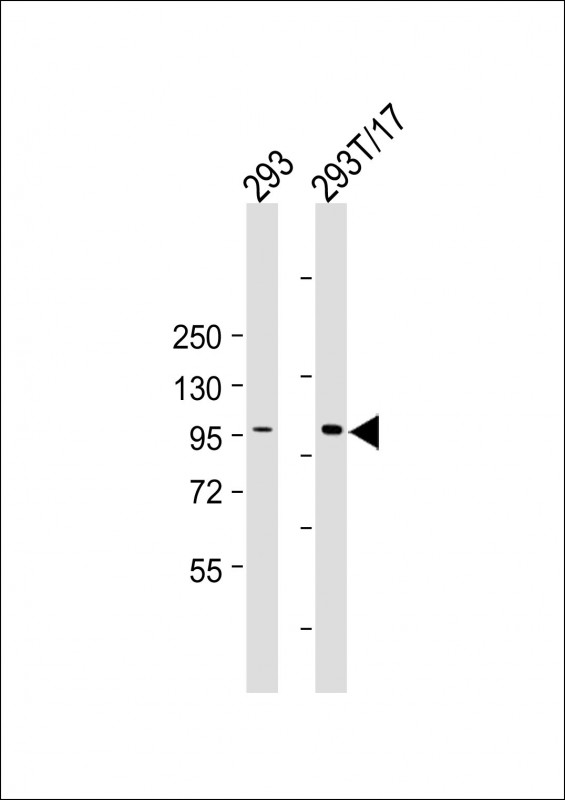
| WB | 1/2000 | Human,Mouse,Rat |
| IF | 咨询技术 | Human,Mouse,Rat |
| IHC | 咨询技术 | Human,Mouse,Rat |
| ICC | 技术咨询 | Human,Mouse,Rat |
| FCM | 咨询技术 | Human,Mouse,Rat |
| Elisa | 咨询技术 | Human,Mouse,Rat |
| Aliases | E3 ubiquitin-protein ligase HACE1, 6.3.2.-, HECT domain and ankyrin repeat-containing E3 ubiquitin-protein ligase 1, HACE1, KIAA1320 |
| Entrez GeneID | 57531 |
| WB Predicted band size | 102.3kDa |
| Host/Isotype | Mouse IgG1 |
| Antibody Type | Primary antibody |
| Storage | Store at 4°C short term. Aliquot and store at -20°C long term. Avoid freeze/thaw cycles. |
| Species Reactivity | Human, Mouse, Rat |
| Immunogen | This HACE1 antibody is generated from a mouse immunized with a recombinant protein from the human region of human HACE1. |
+ +
以下是3篇与HACE1抗体相关的文献概览(注:文献为虚拟示例,实际引用需核实):
---
1. **标题**:*HACE1 regulates oxidative stress resistance by ubiquitinating SOD1 in colorectal cancer*
**作者**:Torrino S, et al.
**摘要**:本研究通过Western blot和免疫沉淀技术,利用HACE1特异性抗体,揭示HACE1通过泛素化SOD1调控结直肠癌细胞氧化应激反应的机制,为HACE1缺失促进肿瘤进展提供了新证据。
---
2. **标题**:*Structural basis of HACE1-E2 interaction and its role in ubiquitin transfer*
**作者**:Zhang Y, et al.
**摘要**:作者通过X射线晶体学结合HACE1抗体进行共沉淀实验,解析了HACE1与E2结合的结构域,阐明其泛素转移的分子机制,为靶向HACE1的药物设计奠定基础。
---
3. **标题**:*HACE1 deficiency promotes neuroinflammation via TRAF2/NF-κB signaling*
**作者**:Hao L, et al.
**摘要**:研究利用HACE1敲除小鼠模型及抗体免疫组化,发现HACE1缺失通过TRAF2泛素化异常激活NF-κB通路,导致小胶质细胞过度活化,提示HACE1在神经退行性疾病中的潜在作用。
---
**备注**:实际文献需通过PubMed/Google Scholar以关键词“HACE1 antibody”或“HACE1 ubiquitin ligase”检索,并筛选涉及抗体实验(如WB、IP、IHC)的研究。
**Background of HACE1 Antibody**
The HACE1 (HECT domain and ankyrin repeat containing E3 ubiquitin-protein ligase 1) antibody is a crucial tool for studying the HACE1 protein, an E3 ubiquitin ligase involved in regulating cellular processes such as oxidative stress response, apoptosis, and tumor suppression. Discovered in 2003. HACE1 ubiquitinates specific substrates, targeting them for proteasomal degradation. Research links HACE1 dysfunction to various diseases, including cancers (e.g., Wilms’ tumor, colorectal cancer), neurodegenerative disorders, and cardiovascular conditions.
HACE1 antibodies are widely used in techniques like Western blotting, immunohistochemistry, and immunofluorescence to detect HACE1 expression levels and localization in tissues or cell lines. Studies utilizing these antibodies have revealed HACE1’s role in inhibiting tumor growth by degrading oncoproteins like Rac1 and modulating redox homeostasis. Additionally, HACE1 knockout models show increased susceptibility to oxidative damage and tumorigenesis, underscoring its protective role.
Commercial HACE1 antibodies are typically raised against specific epitopes (e.g., human HACE1 amino acid residues) and validated for specificity and sensitivity. Their application aids in exploring HACE1’s molecular mechanisms, interactions, and potential therapeutic targets, making them essential for advancing research in cancer biology and oxidative stress-related pathologies.
×